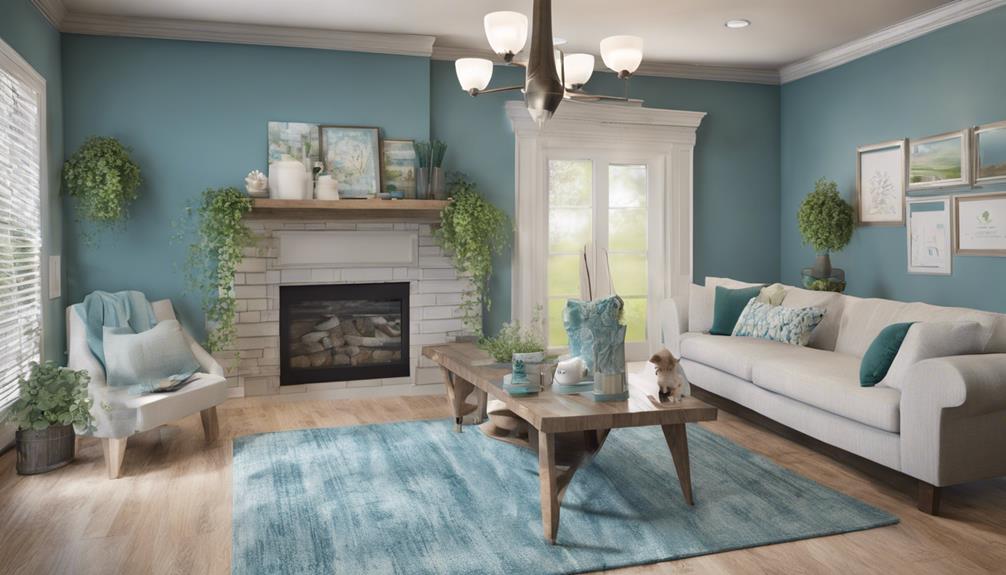When remodeling a home for dementia care, it is crucial to prioritize safety first. Make sure to include features like grab bars, non-slip surfaces, and better lighting to create a safer environment. Tailor the changes to ensure both safety and comfort. Minimize the risk of falls by adding shower chairs and organizing living spaces. Facilitate daily routines with clear labels and consider designing dementia-friendly spaces with contrasting colors and familiar layouts. Plan and allocate a budget for safety improvements such as grab bars and ramps, and consider seeking professional advice for custom adjustments. Start with essential changes before addressing all safety issues. For a more detailed guide on renovating a home for dementia care, please refer to our comprehensive strategies.
Key Takeaways
- Install grab bars and non-slip features in bathrooms.
- Enhance lighting and visibility throughout the house.
- Adapt spaces with dementia-friendly features.
- Seek professional guidance for personalized renovations.
- Prioritize safety and independence in home updates.
Safety Enhancements for Dementia Care
How can we enhance safety for individuals with dementia in their homes?
Making safety enhancements is vital for individuals with dementia. One way to do this is by implementing home modifications that cater to their specific needs. Installing grab bars in bathrooms can prevent falls and provide support. Adding non-slip strips and shower chairs can also enhance safety in these areas. Additionally, adapting bathrooms with dementia-friendly features like easy-to-use faucets and contrasting colors can simplify daily living activities.
Another essential aspect to contemplate is lighting. Enhancing lighting throughout the house can improve visibility and reduce the risk of accidents. Additionally, locking doors, using alarms, and utilizing GPS bracelets can help prevent wandering, ensuring the individual's safety. It's also important to post emergency numbers near phones and address any electrical hazards to minimize fire risks in dementia-friendly homes.
Fall Prevention and Mobility Tips

To enhance safety and promote mobility for individuals with dementia, implementing fall prevention strategies is crucial. Installing grab bars, handrails, and non-skid strips in bathrooms and on stairs can greatly reduce fall risks. Enhancing lighting with LED bulbs and motion sensors improves visibility and safety.
Alarms, locks, and GPS bracelets can help prevent wandering and guarantee better mobility management. Simple tasks like labeling, decluttering, and adapting spaces support daily living activities and reduce fall hazards.
Creating an accessible home environment with ramps, stairlifts, and grab bars is essential for the safety of individuals with dementia. By incorporating these fall prevention and mobility tips, caregivers can provide a secure and supportive environment for their loved ones. Remember, small changes like these can make a significant difference in promoting independence and preventing accidents.
Daily Living Support Strategies
Daily living support strategies for individuals with dementia involve incorporating dementia-friendly features into the home environment. This includes using assistive devices to aid in dressing and grooming, making tasks easier and safer. Contrasting colors can help improve object visibility, making it easier for individuals with dementia to locate items.
Keeping the living spaces critical-free is essential to prevent confusion and accidents. Creating an environment that's supportive, with open and easily navigable spaces, can greatly enhance the daily living experience for those with dementia. By simplifying tasks through clear labeling and organization, individuals with dementia can maintain independence and safety in their daily activities.
These strategies aim to promote a sense of familiarity and security, enabling individuals with dementia to navigate their living spaces with confidence and ease.
Creating Dementia-Friendly Home Environment

Professionals recommend incorporating color contrasts and clear signage for room identification to create a dementia-friendly home environment. By involving architects, designers, and therapists in renovations, we can prioritize cognitive needs in interior design for individuals with Alzheimer's.
Renovations focusing on open, safe, and easily navigable spaces greatly enhance the quality of life for those living with dementia. Essential elements like nightlights and secured rugs contribute to creating a safe environment within a dementia-friendly home.
Personalized adaptations tailored to specific needs and stages of dementia play an important role in transforming a regular home into a supportive environment. These personalized changes can include adjusting furniture layouts, simplifying décor, and ensuring clear pathways to prevent confusion.
Investment and Planning for Renovations
When considering dementia care renovations, it's essential to start by budgeting for the necessary changes. Determining the costs involved in implementing safety features and planning for potential updates over time is crucial. Creating a timeline for home updates can help in organizing the renovation process efficiently. This ensures that safety features are installed promptly and effectively.
Installing safety features like grab bars, non-slip flooring, and adequate lighting is critical for enhancing home safety and independence for individuals with dementia.
Budgeting for Renovations
Investing in dementia care renovations necessitates a strategic approach to budgeting, prioritizing safety, and independence to enhance the quality of life for those living with dementia.
When budgeting for these renovations, it's essential to take into account personalized adaptations that cater to the unique needs and stages of individuals with dementia. Seeking guidance from professionals like architects, designers, and therapists can aid in planning and budgeting effectively.
Creating a supportive environment through careful planning and execution of renovations is vital. By personalizing adaptations, you guarantee that the investment aligns with the specific requirements of individuals with dementia, fostering a safe and comfortable living space.
Prioritizing safety and independence in the budgeting process leads to a home that promotes well-being and quality of life for those with dementia.
Timeline for Home Updates
Planning the timeline for home updates is essential when considering investments and renovations for dementia care.
When planning for home modifications for older people or individuals with dementia, it's vital to work closely with occupational therapists, designers, and architects. They can help tailor the renovations to meet specific needs and stages of dementia, guaranteeing the safety and independence of the occupants.
Additionally, exploring assistive technology options and seeking financial assistance for home renovations can be beneficial.
Safety Features Installation
To guarantee a successful implementation of safety features in dementia care renovations, collaboration with architects, designers, and therapists is essential.
When installing grab bars and handrails on both sides, make sure they're securely fixed to support individuals with stability needs. Incorporating a raised toilet and shower chairs can enhance accessibility and comfort.
Consider additional safety measures such as adding lighting to brighten dim areas and reduce trip hazards. Clear labeling of switches and drawers aids in navigation and independence.
Financing Dementia-Specific Modifications

When looking to finance dementia-specific modifications for home safety, exploring options such as home improvement grants and long-term material loans can provide valuable financial assistance. Home improvement grants offer one-time funding specifically for dementia-specific modifications, helping offset construction costs.
On the other hand, long-term material loans provide financial aid for ongoing home safety renovations, allowing for gradual repayment over time. While certain Medicare plans may cover assistive technology devices, they typically don't include construction costs.
Seeking financial aid can greatly help with the expenses associated with dementia-specific home renovations. Planning and budgeting for these modifications are important steps to ensure safety and independence at home. By carefully considering these financing options and incorporating them into your overall plan, you can create a secure environment that caters to the specific needs of individuals living with dementia.
Interior Design for Dementia Care

When designing spaces for individuals with dementia, we prioritize color choices that stimulate memory and aid in recognition.
Simplified layouts help to reduce confusion and promote independence within the home environment.
These design aspects play a vital role in creating a safe and supportive space for those living with cognitive impairments.
Color for Memory Stimulation
Color selection in interior design plays an essential role in stimulating memory for individuals with dementia, invoking positive emotions, and aiding in spatial recognition. Contrasting colors can help those with cognitive impairments identify different rooms, making navigation easier.
Bright and bold colors are beneficial for distinguishing objects and spaces within the environment, improving visual perception. Implementing color-coded signage and labels can enhance memory recall and orientation, promoting independence in daily activities.
Professional interior designers utilize color psychology to create a supportive and stimulating environment for individuals with dementia, focusing on colors that evoke positive emotions and trigger memories. By incorporating these strategies, caregivers can help create a safe and comfortable living space that supports the unique needs of those with dementia.
Simplified Layout Design
In designing interiors for dementia care, emphasizing a simplified layout aims to reduce confusion and improve navigation for individuals with cognitive impairment. By incorporating clear room identification using color contrasts and signage, individuals with dementia can better orient themselves in their living environment.
Including familiar and meaningful elements in the interior design can evoke positive memories and reduce anxiety for those with dementia. Professional input from architects, designers, and therapists is essential for creating a dementia-friendly home that supports cognitive needs.
Renovations prioritizing simplicity, clarity, and ease of navigation enhance the quality of life for individuals with dementia. Creating a space that's both safe and familiar can greatly benefit those living with cognitive impairments.
Navigating Renovation Process for Safety

To successfully navigate the renovation process for safety in dementia care, consulting with professionals who specialize in dementia-specific adaptations is essential. These experts, such as occupational therapists and designers, can offer valuable insights and recommendations to create a home environment that caters to the specific needs of individuals with dementia.
When beginning on the renovation journey, consider the following key points:
- Collaborate with professionals who understand the unique challenges of dementia care.
- Assess home safety hazards and prioritize necessary changes room by room.
- Personalize adaptations to provide a supportive and secure living space for individuals with dementia.
Frequently Asked Questions
How Do You Make a Home Safe for a Person With Dementia?
We make a home safe for a person with dementia by installing grab bars, using color contrasts, implementing safety measures like alarms, simplifying tasks with clear labels, and collaborating with dementia care professionals for tailored renovations prioritizing safety and functionality.
What Are 3 Things to Never Do With Your Loved One With Dementia?
In caring for a loved one with dementia, we never argue, correct memories, or rush them. Instead, we offer patience, understanding, and a safe environment. Respect their reality, provide gentle guidance, and cherish their dignity.
How Can I Make My House Dementia Friendly?
We can make our house dementia-friendly by using contrasting colors, clear signage, and involving dementia care professionals in renovations. Installing nightlights, securing rugs, and creating open, safe spaces prioritize safety and independence for a supportive environment.
What Stage of Dementia Is Wanting to Go Home?
In mid-stage dementia, the desire to 'go home' often surfaces due to confusion and memory loss. Caregivers should offer reassurance and comfort to address this common symptom effectively, understanding the emotional significance behind it.
How Can Home Renovations for Dementia Care Help Prevent PTSD in Family Caregivers?
Home renovations for dementia care can greatly benefit family caregivers and PTSD. By creating a safe and supportive environment tailored to the needs of the individual with dementia, caregivers can experience reduced stress and trauma, thus helping to prevent the onset of PTSD.
Conclusion
In summary, renovating your home for dementia care is essential for ensuring the safety and well-being of your loved one.
Remember, safety enhancements, fall prevention measures, daily living support strategies, and creating a dementia-friendly environment are key aspects to keep in mind.
By investing in these renovations and planning ahead, you can create a secure and comfortable space for your loved one to thrive.
As the saying goes, 'safety first' when it comes to dementia care at home.









